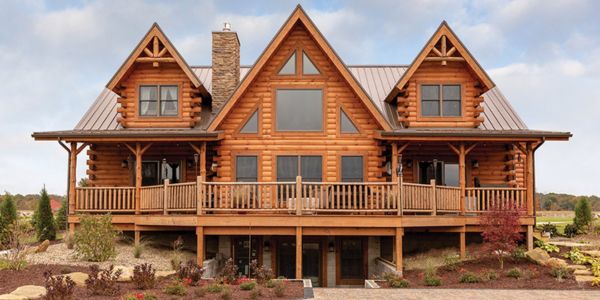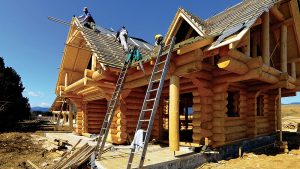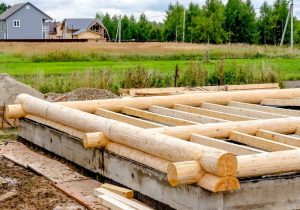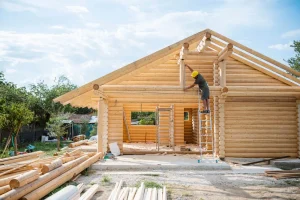For a home that combines natural beauty with lasting strength, building a log house is one of the best things you can do. Choosing the right wood is the first important step toward building your dream home, whether it’s a cozy cabin in the woods or a home in the country where you live full-time. The type of wood you use directly impacts how long your cabin lasts, how well it insulates, how it looks, and how much upkeep it needs. You can build a log home that lasts for generations if you know how different types of wood work and what factors are most important.
Understanding How Important It Is to Choose the Right Wood
Picking the right wood isn’t just about how it looks; it’s also about making sure the structure stays strong and the wood is comfortable over time. How well your cabin stands up to the weather, bugs, and staying warm in the winter depends on the wood you choose. If you choose the right kind of wood, you can avoid expensive fixes and upkeep. For instance, some species naturally don’t break down, while others do better in dry or cold places. Knowing about these qualities before you start building can help you avoid problems in the future and make sure that your log house is always warm, safe, and welcoming.
Which kinds of wood are best for building a log cabin?
You can use a variety of wood types to construct a log house, each possessing unique benefits and qualities. Which one you choose will rely on your income, the weather, and the style you want. Some types of wood naturally resist decay, while others stand out because they are strong or cheap.
Pine is easy to find and doesn’t cost much, so a lot of people use it to build log houses. It’s light and soft, so it’s easy to cut and shape. Pine is more prone to rot, so covering and caring for it is vital to prolong its life.
Cedar is very valuable because it naturally doesn’t rot or attract bugs. Its strong smell also keeps bugs away. Cedar logs look wonderful as they age because they turn dark and warm over time. Cedar is more expensive, but it lasts longer and needs less upkeep, so it’s a wonderful choice for homeowners who want to make an investment that will pay off over time.
Spruce is also a great choice, especially for places that get cold. It is strong and light at the same time, and the fine, even grain gives houses a classic, finished look. It’s not naturally bug-proof, but if you treat it right, it can last for decades.
Douglas Fir is very strong and stable, which makes it perfect for building parts. Its reddish-brown color makes both inside and outside of your home feel warmer. It will last a long time if you take care of it, even though it needs decay treatment.
Cypress is thought to be the best wood for building log homes. Cypress does very well in wet or coastal areas because it is naturally resistant to water and insects. Its golden color and lovely grain make your house look both fancy and country.
Things to Think About When Picking Wood
There’s more to picking the best wood than just looking at it. How well your logs work in your setting depends on a number of real things.
Weather: The type of wood you choose should depend on the weather where you live. For instance, in wet places, cedar and cypress are great woods because they don’t rot. In colder places, spruce or pine might be better.
Budget: The cost of wood varies a lot. Pine is inexpensive and easy to find. Cedar and cypress, on the other hand, cost more but last longer. Think about both the original prices and the costs of long-term upkeep.
Sustainability: Choose wood that was harvested in an eco-friendly way if you want to build a house that will last. Check to see if the logs have been approved by groups such as the Forest Stewardship Council (FSC). Sustainable logging makes sure that the building of your home has little effect on the environment.
Attractiveness: Every type of wood has its own look. Cedar and cypress give the wood a warm, rich look, while pine gives it a light, rustic look. The mood of your bedroom will depend on what you choose.
Upkeep: Different types of woods need different amounts of care. Softer types, like pine, may need to be stained or sealed more often to keep them from rotting. Harder woods that are naturally resistant to damage, like cedar, need less maintenance.
How to Keep Your Cabin Wood in Good Shape
To stay strong and beautiful, even the best wood needs to be taken care of. If you take care of your wood house the right way, it will protect your property and last for a long time. After building, use a good sealer and then repaint it every few years to keep water out. This step stops the wood from twisting, breaking, and growing mold.
Check the outside of your cabin often, especially after bad weather. Watch for rotting spots, bug activity, or cracks that are starting to show up. Fix them as soon as you see them. Once a year, give your cabin a light wash to get rid of dirt and mildew. It is also important to make sure that the area around your base drains properly, since wood doesn’t do well in standing water. Your logs will look new and strong for decades if you follow these steps.
Choices of eco-friendly wood for long-lasting cabins
Many people today are building in a more environmentally friendly way. There are many eco-friendly choices for your log house if you care a lot about the environment. One of the best is used wood. It comes from old barns, mills, and other buildings. It gives your house a unique, ancient look and helps the environment at the same time.
Forest-friendly options also include synthetic wood, which is made from squished wood fibers. Stability, regularity, and low energy use are all benefits of this method, which also uses fewer trees. Using wood from nearby sources also lowers the pollution caused by shipping and helps local economies. If you choose these options and add energy-efficient features like big windows for natural light and good insulation, your log house will be good for the environment and save you money.
How to Choose Wood Without Making These Common Mistakes
Many first-time builders make the mistake of only caring about how much it costs or how it looks. Both are important, but ignoring how long the wood will last and how often it needs to be maintained can cause big problems in the future. If you live in a wet area, don’t choose raw softwoods or ignore the weather. Before you start building, you should always make sure that your logs are properly seasoned, or dried. Green wood may shrink or twist as it dries, which could lead to structural issues. Remember to apply protective coatings to your logs to prevent them from rotting or insect damage.
Q&A
1. What kind of wood is best for making a log house that will last?
Because they don’t naturally rot, swell, or attract bugs, cedar and cypress are two of the best choices for long-lasting wood.
2. Can wood be used to make a log cabin?
Pine is cheap and easy to work with, but it needs to be sealed and cared for regularly to keep it from rotting.
3. Which type of wood is best for the environment?
It is best to use reclaimed wood or FSC-certified firewood because they help protect trees and have less of an impact on the earth.
4. What can I do to keep bugs out of my log cabin?
Cedar and cypress are natural insect-resistant woods that you should use. Also, use a protective finish to seal any cracks or holes that pests could get into.
5. Does the weather change the wood I choose?
Of course. If you live in a wet area, choose wood that doesn’t absorb water; if you live in a cold area, choose wood that is strong and keeps heat in.
In conclusion
The strength, beauty, and comfort of your log house will depend on the wood you choose for its building for many years to come. Each type has its own benefits, such as strong Douglas fir, beautiful cypress, long-lasting cedar, and cheap pine. The important thing is to pick something that fits your surroundings, price, and how you like to take care of things. Picking the right wood for your house will not only make it look better, but it will also keep it warm, safe, and long-lasting for generations to come. If you build it right and take care of it regularly, your log house will always be a beautiful example of nature’s workmanship.




